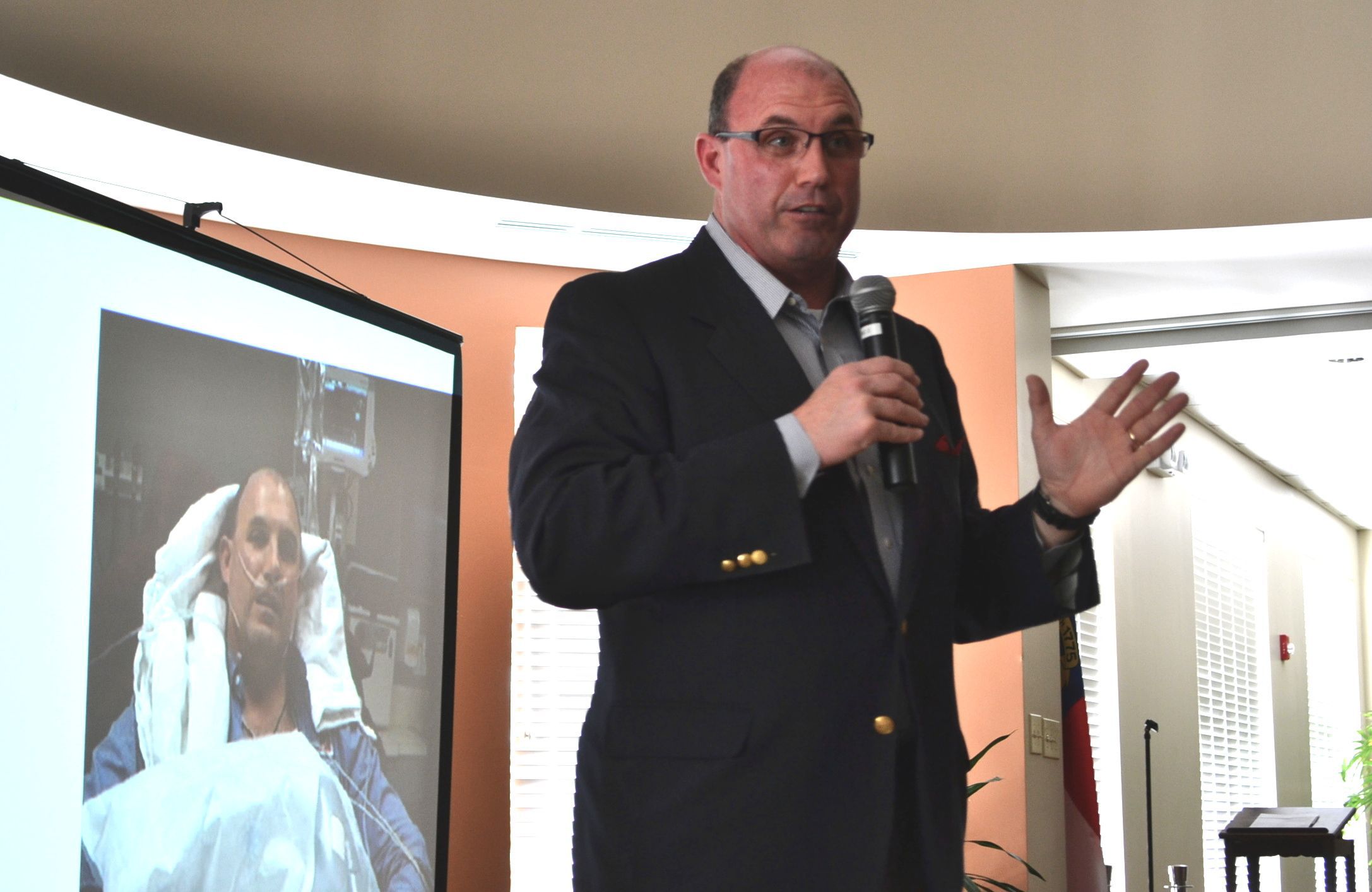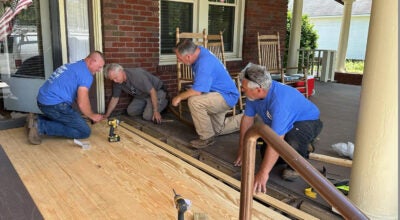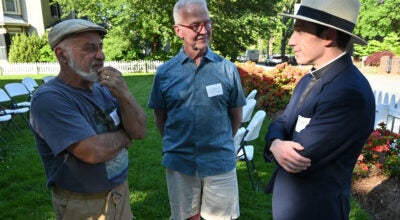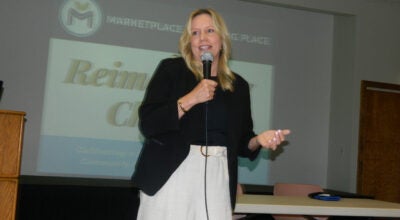Miracle on the Hudson Sanderson’s experience as passenger on famous flight leads to career as a motivational speaker
Published 12:00 am Thursday, March 27, 2014
SALISBURY — In the five years since Capt. Chesley “Sully” Sullenberger miraculously landed his disabled US Airways jetliner on the Hudson River and all 155 aboard survived, Dave Sanderson has appeared in public with the pilot three times.
In Charlotte, on one of those occasions, Sanderson was able to steal a minute with Sullenberger and ask him what he always wanted to know: “What was ‘The Moment’?” Sanderson asked.
Sullenberger told him it wasn’t the actual landing on the water, as you might suspect. Rather, it was getting the jetliner over the George Washington Bridge.
Flight 1549 came much closer to crashing into the bridge than most people ever realized, which would have transformed the day’s well-documented miracle into a tragedy of mammoth proportions.
Sanderson shared that anecdote and others Wednesday when he spoke to a crowd of close to 100 at Trinity Oaks.
Sanderson, the last passenger off Flight 1549 that day, has now spoken publicly about the “Miracle on the Hudson” 491 times.
Four weeks ago, he said, he finally gave up his sales job at Oracle to focus full-time on his motivational speaking program — “Create Your Own Flight Plan.”
His presentations have taken him around the world. He still calls Charlotte home, which was his destination flying out of LaGuardia Airport the day of the Miracle on the Hudson flight.
Sanderson weaves in messages such as faith, trust, gratitude, responsibility, courage, leadership and maintaining control in crisis. He speaks with humility, though his actions that day were heroic and, in the end, life-threatening.
More than once, Sanderson heard his late mother’s words coming back to him after the jetliner was on the water. He said his first thought was to reach the aisle of the plane and get out as fast as possible.
But his mother had always said, “If you do the right thing, God will take care of you.”
So Sanderson stayed behind and made sure everyone from the back of the plane could make their way out to the wings.
The second time his mother’s words flooded back to him was moments before his rescue from the frigid, 36-degree water of the Hudson.
A tug boat, trying to be part of the rescue effort, bumped the plane, and Sanderson felt water, which had been waist-deep, go up his back.
Fearing that if the plane sunk rapidly he would be drawn down with it like passengers on the Titanic, Sanderson jumped into the river and swam as much as his numb-with-cold body would allow to the nearest rescue vessel.
When he reached the side of the boat, he was too paralyzed with cold to attempt getting up a ladder or raising his arms. “I can’t,” he told the people above him.
It’s then he heard his mother words again. She liked to say, “If you can’t, you must.”
Sanderson managed to raise his arms high enough to be grabbed by two men in the boat and pulled out of the water.
“Everyone has a hero inside,” Mike Walsh, executive director of Trinity Oaks, said in introducing Sanderson. Even when he could barely function from the cold, Walsh added, he worked to save others.
“God wanted me on that plane,” Sanderson said.
The morning of Jan. 15, 2009, Sanderson was working at a Brooklyn distribution center and had finished early. He arranged to catch an earlier flight home to Charlotte, and was booked on Flight 1549.
The day was snowy and 11 degrees. Sanderson’s seat was four rows behind the left wing. He pulled a magazine out and paid no attention to the pre-flight instructions about where the emergency exits were or how to react in a crash situation.
Not long after takeoff, Sanderson and other passengers heard an explosion. Sanderson saw fire coming out of the left wing and assumed the plane had lost an engine but would still be able to return to LaGuardia.
He had no idea a flock of birds also had disabled an engine on the right side of the plane. “It was so quiet you could hear a pin drop,” Sanderson recalls of how people were reacting.
The only three words they would hear from Sullenberger were “Brace for impact.”
“I never heard that on a plane before,” Sanderson said.
Sanderson made several quick prayers and retrieved his wallet from his briefcase and shoved it into his pants, so he could possibly be identified after a crash.
A minute later came the landing. Sullenberger later estimated they hit the water still traveling at a speed of 100 to 120 mph. On impact, Sanderson said, he and other passengers flew all the way up and all the way back in their seats, breaking most of them.
The broken seats actually were used by passengers as tools for making their way out of the emergency exits and onto the wings. Meanwhile, water was coming from underneath and the back of the fuselage.
Things were happening fast, Sanderson said, describing a controlled chaos. The overhead bins also collapsed and all kinds of bags and seats were scattered on the floor. Things were fairly dark, too. Sanderson said with every step he took, he hit something, and at first he worried it was people.
By the time Sanderson had helped everyone else and reached the door, there was no room on the wing. (He was on the New Jersey side of the plane.)
Sanderson judged he was in waist-deep water 7 minutes. The Hudson River currents were strong, and the plane floated a half mile in 24 minutes, he added.
Sanderson was clinging to the side close to a mother holding a 3-month-old infant. To get on a rescue boat, it was evident the mother would have to give up the infant — something she was reluctant to do.
“I yelled at her, ‘Throw the baby, throw the baby,’” Sanderson recalled. “… I don’t think that was one of my finer moments, but that’s what it took for her to give the baby up.”
The mother was able to hand off the baby to a mother of three from Knoxville, Tenn., and make it to safety herself.
The woman later sent Sanderson a large color portrait of the toddler being held by Sullenberger.
Once Sanderson himself was safely on a boat chugging toward the New Jersey side of the river, he used the iPhone of a survivor in a gray suit to call his home in Charlotte.
He left a message saying only he had been in a plane crash.
Sanderson played that message from his phone for his audience Wednesday.
His daughter, then a junior in high school, heard the voicemail soon after and contacted her mother and the couple’s three other children.
Sanderson’s wife was taking their son to basketball practice.
Things were touch and go for Sanderson for the next few hours. He was suffering from hypothermia. His blood pressure was 190 over 120. His oxygen level was at 75, and his body temperature registered only 94.
Medical personnel worried he could suffer a heart attack or stroke.
In a triage unit, Sanderson was stripped of all his cold, wet clothes down to his underwear, which were frozen to his body and had to be cut off.
He then went to a nearby hospital. As he warmed up and was out of danger in the hours to come, Sanderson gave one of the first live accounts of the landing to Katie Couric of CBS. He also met the governor of New Jersey, the head of the New York Ports Authority, the heads of the N.Y. and N.J. state highway patrols and representatives of the FBI and Homeland Security.
Amazingly, Sanderson said, they all wanted to talk with him because most of the other passengers already were being taken care of by US Airways and finding their way home.
More than once, Sanderson was asked whether he thought it was terrorist attack.
Sanderson pulled several strings with those authorities he had met to rush home later by plane to his wife and children. A passenger next to him noticed that it was Sanderson’s photo from a hospital bed on Page 4A of the Newsday he was reading.
On the Sunday after the Hudson River landing, Sanderson was asked to speak at the men’s pancake breakfast of his Methodist church. He was surprised when 600 people showed up.
Sanderson told stories Wednesday of how his speaking appearances have left impressions with the very young and very old.
One elderly woman told him after his first talk that “Now I believe there is a God, who performs miracles.”
And maybe that’s the lasting message of the Miracle on the Hudson, even five years removed.
“You were watching, because it gave people hope,” Sanderson says.
Residents of Trinity Oaks will be traveling to the Aviation Museum in Charlotte today to see the plane that made the miracle landing on the Hudson River.
Contact Mark Wineka at 704-797-4263.






